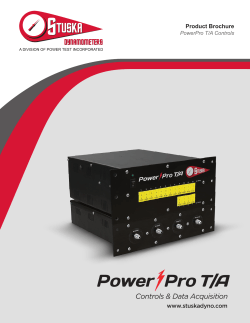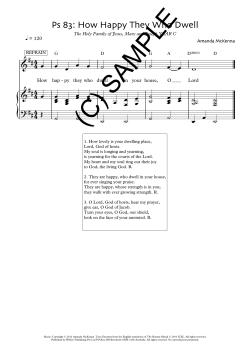
Agenda Anatomy of a Pulse Anatomy of a Pulse
5/1/2015 Agenda I Anatomy of a Pulse I I Electromagnetic Interference Testing (EMI) Basics - Part 1 Capturing Pulsed / Intermittent Signals with Frequency Swept, Frequency Stepped, and Time Domain Scan Methodologies I Architectures / Methodology I I Photo Goes Here Real World Signals Spectrum I Bill Wangard I Bill Wangard is the EMI Receiver and Radio monitoring Product Manager at Rohde & Schwarz. He has 20+ years of RF and Receiver experience at Motorola and Rohde & Schwarz. Bill authored numerous patents at Motorola. Frequency Swept Frequency Stepped Time Domain Scan Measurement / Dwell Time I Comparison Videos I Frequency Swept vs Frequency Stepped vs Time Domain Scan Anatomy of a Pulse Anatomy of a Pulse Pulse Spectrum Real World Signals → Real World Problems I Examples in real world I Switched Mode Power Supplies I Radar systems I Serial data emissions I Valve opening / closing I Systematic arching (brush motor at constant RPM) I Short duration events with heating considerations Ʈ – pulse width T - PRI frequency Anatomy of a Pulse Anatomy of a Pulse Pulsed / Intermittent Signals Frequency and Time Domain Pulsed Emissions I Minimum dwell time at each frequency in order to catch a pulse I Related to pulse repetition rate I If pulse occurs once every 10 ms… I Then I We must dwell for I 10 ms at each eque cy … I frequency 1 5/1/2015 Agenda Basic Architectures RBW Sweep time I Anatomy of a Pulse I I Real World Signals Spectrum I Swept Analyzer I Architectures / Methodology I I I I Frequency Swept Frequency Stepped Time Domain Scan Measurement / Dwell Time I Signal Analyzer - aka I I I Comparison Videos I Frequency Swept vs Frequency Stepped vs Time Domain Scan Modern EMI Receiver Architecture RF Wideband IF I I FFT Analyzer Vector Signal Analyzer Time-Domain Analyzer Real-time Analyzer IF BW Processing Architectures Spectrum Analyzer vs. EMI Receiver Digital Data I Local Oscillator I Detector DSP A D Digital RBW Filter Digital Detectors y Local Oscillator x Local Oscillator - Sweeping vs. Scanning I I Pre-Amp & Pre-selection Methodology Architetures I I IF Filter Controls the measurement frequency Spend enough time at each frequency to detect pulsed emissions Frequency Swept (Spectrum Analyzer) I I I y x Continuously swept across frequency range What is measurement time at each frequency? I Time = Sweep Time / Sweep Points What is the Spacing/Step size between measurements? I Step = Frequency Span / (Sweep Points -1) Example: - 801 pts over 200M - 1GHz - 1 MHz per point - Sweep rate constant across span - Reduced frequency resolution 2 5/1/2015 Methodology Methodology Frequency Stepped (EMI Receiver) Time Domain Scan Tuned (stop) at each point Directly set the measurement time (dwell time) Directly set the frequency step size I The Discrete Fourier Transform (DFT) is a numerical mathematical method that calculates the spectrum for a periodic signal I Use DFT to simultaneously measure many frequencies in parallel Example: - 4M pts over sweep range (frequency resolution) - RBW overlap to reduce frequency related amplitude errors or picket fences - Dwell time per frequency - Automatic Gain Control (AGC) I The Fast Fourier Transform (FFT) is an efficient algorithm to compute the DFT using symmetry and repetition properties I FFT is much faster than DFT due to reduced number of multiplications I I I Methodology Methodology Time Domain Scan Time Domain Scan Time-domain Sample the frequency interval with high sampling rate Frequency domain Split the measured frequency range into consecutive frequency intervals f F(s) f(t) Frequency domain Merge the spectra of all frequency blocks Fast-Fourier transformation Transform the signals from time domain to frequency domain Measurement / Dwell Time Measurement / Dwell Time Frequency Stepped Scan Time Domain Scan Input Signal I Pulse Modulated I 12 ms pulse period Input Signal I Pulse Modulated I 12 ms pulse period Even 10 ms measurement time yields a closed trace Zooming in reveals gaps in the trace Closed trace with 12 ms measurement time Gaps in trace with 10 ms measurement time Important: Measurement time ≥ signal period 3 5/1/2015 Measurement / Dwell Time Agenda Spectrum Analyzer Zero Span Mode I Anatomy of a Pulse I Input Signal I Pulse Modulated I 12 ms pulse period I Real World Signals Spectrum I Architectures / Methodology I I Zero span display in spectrum analyzer measures signal period / pulse repetition rate I I Frequency Swept Frequency Stepped Time Domain Scan Measurement / Dwell Time I Comparison Videos I Series of Videos I Videos 1-5: I Input signal: 10ms pulse period (repetition rate) with 10us pulse duration @ 700MHz I RBW = 100kHz Video # Time Duration Freq Range Method Sweep/Dwell Time 1 1:34 30M – 1G Swept Auto: 1.3ms 2 2:31 30M – 1G Swept Per MIL-STD461: 146sec 3 0 08 0:08 30M – 1G Ti Time D Domain i Per MIL-STD461: MIL STD461: 15ms 4 4:47 650M – 750M Swept Per MIL-STD461: 15sec 5 0:09 650M – 750M Time Domain Per MIL-STD461: 15ms 6 4:10 650M – 750M Swept / Stepped / Time Domain Notes Frequency Swept Fast Sweep with Max Hold - (1:34) I Conditions I I Freq Resolution: Need to Zoom in Zoom in Freq: Aliasing, Missed Events I I 10ms PRI with 10us pulse duration @ 700MHz Sweep from 30MHz to 1GHz RBW = 100kHz (6dB MIL-STD 461 filters) Default Sweep Time = 1.3ms I MIL-STD MIL STD 461 sweep ti time spec iis 145 145.5sec 5 I (1GHz – 30MHz) * 0.15sec/MHz = 145.5sec I Observations I 1 sec PRI: Time Domain is superior to capture intermittent signals Frequency Swept vs Frequency Stepped vs Time Domain Scan I Take more than 1 minute to capture Almost have to know it’s there, can be misleading Frequency Swept Frequency Swept (2:31) Fast Sweep with Max Hold - (1:34) MIL-STD 461 Spec Sweep Time with Max Hold I Conditions I I I I 10ms PRI with 10us pulse duration @ 700MHz Sweep from 30MHz to 1GHz RBW = 100kHz (6dB MIL-STD 461 filters) Spec’d Spec d Sweep Time = 146sec I MIL-STD 461 sweep time spec is 145.5sec I (1GHz – 30MHz) * 0.15sec/MHz = 145.5sec I Observations I I High probability to capture 10ms PRI pulsed signal, but frequency resolution is not adequate, must zoom in Takes 146sec, 2:26 4 5/1/2015 Frequency Swept (2:31) Time Domain (0:08) MIL-STD-461 Spec Sweep Time with Max Hold MIL-STD 461 Spec’d Dwell Time I Conditions I I I I 10ms PRI with 10us pulse duration @ 700MHz Sweep from 30MHz to 1GHz RBW = 100kHz (6dB MIL-STD 461 filters) Spec’d Dwell Time = 0.015sec = 15ms I Observations I I Event detected and captured in just a few seconds Time Domain is much faster and less likely to miss intermittent event Time Domain (0:08) Frequency Swept (4:47) MIL-STD 461 Spec’d Dwell Time MIL-STD 461 Spec’d Sweep Time I Conditions I I I I 10ms PRI with 10us pulse duration @ 700MHz Sweep from 650MHz to 750MHz RBW = 100kHz (6dB MIL-STD 461 filters) MIL-STD 461 sweep time spec is 15sec I 100MHz * 0.15sec/MHz I Observations I I I Frequency Swept (4:47) MIL-STD 461 Spec’d Sweep Time Many sweeps are required to properly capture the signal Takes nearly 3min despite 15sec sweep time User must be aware of time aliasing if sweep time is an integer number of the PRI Time Domain Scan (0:09) MIL-STD 461 Spec’d Dwell Time I Conditions I I I I 10ms PRI with 10us pulse duration @ 700MHz Sweep from 650MHz to 750MHz RBW = 100kHz (6dB MIL-STD 461 filters) MIL-STD 461 dwell time of 15ms I Observations I Peak found within seconds 5 5/1/2015 Time Domain Scan (0:09) MIL-STD 461 Spec’d Dwell Time Freq Swept vs Freq Stepped vs Time Domain Capture Pulsed Event (4:10) I Conditions I I I I 1s PRI with 10us pulse duration @ 700MHz Sweep from 650MHz to 750Hz RBW = 100kHz (6dB MIL-STD 461 filters) Frequency Swept: Adjust Sweep Time from 1s to 20s I Observations Ob ti I I I Frequency Swept I Takes a very long time I Aliasing is prevalent, especially when ST = 10s and 20s Frequency Stepped I Video shows just enough to demonstrate will take a long time Time Domain Scan I Peak found within seconds with no issue of time aliasing Freq Swept vs Freq Stepped vs Time Domain Summary Capture Pulsed Event (4:10) I Pulsed / Intermittent signals are prevalent throughout industry and must be properly detected / characterized I Advances in DSP technology enabled new methodology of Time Domain Scan I Also enhanced EMI Diagnostic capability, see Part 2 I Traditional Spectrum Analyzer Frequency Swept methodology has limitations that must be understood to yield proper results Sweep Time I # of Points I Frequency Resolution I I Time Domain Scan is very powerful methodology for detecting and characterizing Pulsed / Intermittent Signals Thanks for attending! Don’t miss our Test Bootcamp! November 12, 2015 www.emclive2015.com 6
© Copyright 2025









